Open-Access Crystal Plasticity Finite Element Implementation in ANSYS for Dislocation-Induced Nanoindentation in Magnesium
Abstract
1. Introduction
2. Materials and Methods
2.1. The Development of User-Defined Code
2.2. The Validation of the User-Defined Code
- As shown in Figure 2a, when the load is applied parallel to the c-axis, the CPFEM code predicts the onset of plasticity at 104 MPa, closely matching the value (100 MPa) reported by Graff et al. [30]. The stress–strain curve plateaus around 292 MPa, aligning with the scattered Kelley–Hosford experimental results (290–330 MPa) and exhibiting a percentage error of 7.2% compared to Graff’s results. The predicted activities of involved slip systems are consistent with prior studies, showing dominant pyramidal <c + a> slip, with prismatic slips activating at higher strains, as shown in Figure 2b.
- When the load is applied perpendicular to the c-axis, the stress–strain curve plateaus at approximately 184.2 MPa, agreeing well with the reported 195–200 MPa (Kelley–Hosford experiments) and 205 MPa (Graff et al.), as shown in Figure 2c. It should be noted that prismatic slips are the only activated system as shown in Figure 2d.
- Figure 2e,f show comparisons when the load is applied at 45° to the c-axis. The simulated stress–strain results closely matched both studies, with basal slip dominating plastic flow at approximately 3.4 MPa. The simulated maximum stress (6.55 MPa) shows a percentage error of 3.8% compared to 6.3 MPa (Graff et al.) and 12% compared to 5.7 MPa (Kelley–Hosford experiments). The discrepancies between simulations with the Kelley–Hosford experiments are likely attributed to the limited data points.
2.3. Applications of ANSYS Code for Nanoindentation
2.3.1. The Finite Element Mesh
2.3.2. Mesh Refinement
2.3.3. Contact Pair
2.3.4. Boundary Conditions
2.3.5. Load Steps
2.3.6. Time Stepping
2.3.7. Post-Processing
3. Results and Discussion
3.1. Nanoindentation Behavior While Indented Along C-Axis
3.2. Nanoindentation Behavior While Indented Along A-Axis
3.3. Slip System Activities Across Different Grains
4. Conclusions
Author Contributions
Funding
Conflicts of Interest
References
- Roters, F.; Eisenlohr, P.; Hantcherli, L.; Tjahjanto, D.D.; Bieler, T.R.; Raabe, D. Overview of constitutive laws, kinematics, homogenization and multiscale methods in crystal plasticity finite-element modeling: Theory, experiments, applications. Acta Mater. 2010, 1152, 58–1211. [Google Scholar] [CrossRef]
- Tasan, C.C.; Hoefnagels, J.M.; Diehl, M.; Yan, D.; Roters, F.; Raabe, D. Strain localization and damage in dual phase steels investigated by coupled in-situ deformation experiments and crystal plasticity simulations. Int. J. Plast. 2014, 63, 198–210. [Google Scholar] [CrossRef]
- Huang, Y. A User-Material Subroutine Incroporating Single Crystal Plasticity in the ABAQUS Finite Element Program; Harvard University: Cambridge, UK, 1991. [Google Scholar]
- Wu, Y.; Shen, Y.; Chen, K.; Yu, Y.; He, G. Multi-scale crystal plasticity finite element method (CPFEM) simulations for shear band development in aluminum alloys. J. Alloys Compd. 2017, 711, 495–505. [Google Scholar] [CrossRef]
- Asim, U.B.; Siddiq, M.A.; Kartal, M.E. A CPFEM based study to understand the void growth in high strength dual-phase titanium alloy (Ti-10V-2Fe-3Al). Int. J. Plast. 2019, 122, 188–211. [Google Scholar] [CrossRef]
- Iftikhar, C.M.A.; Li, Y.L.; Kohar, C.; Inal, K.; Khan, A.S. Evolution of subsequent yield surfaces with plastic deformation along proportional and non-proportional loading paths on annealed AA6061 alloy: Experiments and crystal plasticity finite element modeling. Int. J. Plast. 2021, 1029, 14356. [Google Scholar] [CrossRef]
- Patra, A.; Chaudhary, S.; Pai, N.; Ramgopal, T.; Khandelwal, S.; Rao, A.; McDowell, D.L. ρ-CP: Open source dislocation density based crystal plasticity framework for simulating temperature-and strain rate-dependent deformation. Comput. Mater. Sci. 2023, 224, 112182. [Google Scholar] [CrossRef]
- Nguyen, T.N.; Abbès, F.; Lecomte, J.-S.; Schuman, C.; Abbès, B. Inverse identification of single-crystal plasticity parameters of HCP zinc from nanoindentation curves and residual topographies. Nanomaterials 2022, 12, 300. [Google Scholar] [CrossRef]
- Kainer, K.U. Magnesium—Alloys and Technologies; WILEY-VCH GmbH & Co. KGaA: Weinheim, Germany, 2003. [Google Scholar]
- Liu, M.; Lu, C.; Tieu, K.A.; Zhou, K. Crystal plasticity FEM study of nanoindentation behaviors of Cu bicrystals and Cu–Al bicrystals. J. Mater. Res. 2015, 2485, 30–2499. [Google Scholar] [CrossRef]
- Su, H.; Wang, J.; Liu, C.; Yan, C.; Tian, G.; Yang, Z.; Xue, C.; Yang, X.; Li, Q.; Li, X.; et al. Orientation dependence of intracrystalline and grain boundary deformation behavior in Mg-2Y using nanoindentation and CPFEM. J. Alloys Compd. 2024, 994, 174688. [Google Scholar] [CrossRef]
- Casals, O.; Forest, S. Finite element crystal plasticity analysis of spherical indentation in bulk single crystals and coatings. Comput. Mater. Sci. 2009, 45, 774–782. [Google Scholar] [CrossRef]
- Casals, O.; Očenášek, J.; Alcala, J. Crystal plasticity finite element simulations of pyramidal indentation in copper single crystals. Acta Mater. 2007, 55, 55–68. [Google Scholar] [CrossRef]
- Selvarajou, B.; Shin, J.; Ha, T.; Choi, I.; Joshi, S.; Han, H. Orientation-dependent indentation response of magnesium single crystals: Modeling and experiments. Acta Mater. 2014, 81, 358–376. [Google Scholar] [CrossRef]
- Kweon, S.; Raja, D.S. A study on the mechanical response of magnesium using an anisotropic elasticity twinning CP FEM. Arch. Appl. Mech. 2021, 4239, 91–4261. [Google Scholar] [CrossRef]
- Martin, R.S. Micromechanics of Magnesium and Its Alloys Studied by Nanoindentation. Ph.D. Thesis, Universidad Carlos III de Madrid, Madrid, Spain, 2016. [Google Scholar]
- Catoor, D.; Gao, Y.; Geng, J.; Prasad, M.; Herbert, E.; Kumar, K.; Pharr, G.; George, E. Incipient plasticity and deformation mechanisms in single-crystal Mg during spherical nanoindentation. Acta Mater. 2013, 61, 2953–2965. [Google Scholar] [CrossRef]
- Lin, P.-D.; Nie, J.-F.; Lu, Y.-P.; Shi, C.-X.; Cui, S.-G.; Cui, W.-D.; He, L. Atomic irradiation defects induced hardening model in irradiated tungsten based on molecular dynamics and CPFEM. Int. J. Plast. 2024, 174, 103895. [Google Scholar] [CrossRef]
- Xiao, X.; Li, S.; Yu, L. Effect of irradiation damage and indenter radius on pop-in and indentation stress-strain relations: Crystal plasticity finite element simulation. Int. J. Mech. Sci. 2021, 199, 106430. [Google Scholar] [CrossRef]
- Foumani, M.I.; Khursheed, S.T.; Liu, Y.; Zhu, G. Orientation-dependence of Incipient Plasticity in a Coarse-grained Mg Revealed by Nanoindentation Pop-ins. J. Magnes. Alloy 2025, 13, 2554–2564. [Google Scholar] [CrossRef]
- Khursheed, S.T. Simulation of the Nanoindentation Response in Single-Crystal Magnesium Using Crystal-Plasticity Finite Element Methods. Master’s Thesis, University of Manitoba, Winnipeg, MB, Canada, 2024. [Google Scholar]
- Xi, B.; Fang, G. Crystal plasticity behavior of single-crystal pure magnesium under plane-strain compression. Rare Met. 2017, 36, 541–549. [Google Scholar] [CrossRef]
- Zhang, J.; Du, S.; Ding, S. Crystal plasticity finite element modeling of twin band formation and evolution together with the macroscale mechanical responses of hexagonal metals. Mater. Sci. Eng. A 2022, 855, 143856. [Google Scholar] [CrossRef]
- Taylor, G.I. Plastic strain in metals. J. Inst. Met. 1938, 62, 307–324. [Google Scholar]
- Long, T.R.; Smith, C.S. Single-crystal elastic constants of magnesium and magnesium alloys. Acta Metall. 1957, 5, 200–207. [Google Scholar] [CrossRef]
- Hooke, R. Lectures de Potentia Restitutiva, or of Spring Explaining the Power of Springing Bodies; John Martyn: Thomastown, Ireland, 2016. [Google Scholar]
- Itin, Y. Cauchy relations in linear elasticity: Algebraic and physics aspects. J. Elast. 2023, 156, 39–77. [Google Scholar] [CrossRef]
- Hill, R. Generalized constitutive relations for incremental deformation of metal crystals by multislip. J. Mech. Phys. Solids 1966, 14, 95–102. [Google Scholar] [CrossRef]
- Agnew, S.R.; Yoo, M.H.; Tomé, C. Application of Texture Simulation to Understanding Mechanical Behavior of Mg and Solid Solution Alloys Containing Li or Y. Acta Mater. 2001, 49, 4277–4289. [Google Scholar] [CrossRef]
- Graff, S.; Brocks, W.; Steglich, D. Yielding of magnesium: From single crystal to polycrystalline aggregates. Int. J. Plast. 2007, 23, 1957–1978. [Google Scholar] [CrossRef]
- Ansys® Mechanical APDL, Release 2023 R2, Help System. In Element Reference; Ansys, Inc.: Canonsburg, PA, USA, 2023.
- Kelley, E.W.; Hosford, W. Plane-strain compression of magnesium and magnesium alloy crystals. Trans. Met. Soc. AIME 1968, 242, 5–13. [Google Scholar]
- Zhang, J.; Joshi, S. Phenomenological crystal plasticity modeling and detailed micromechanical investigations of pure magnesium. J. Mech. Phys. Solids 2012, 60, 945–972. [Google Scholar] [CrossRef]
- Gan, Y.; Song, W.; Ning, J.; Tang, H.; Mao, X. An elastic–viscoplastic crystal plasticity modeling and strain hardening for plane strain deformation of pure magnesium. Mech. Mater. 2016, 92, 185–197. [Google Scholar] [CrossRef]
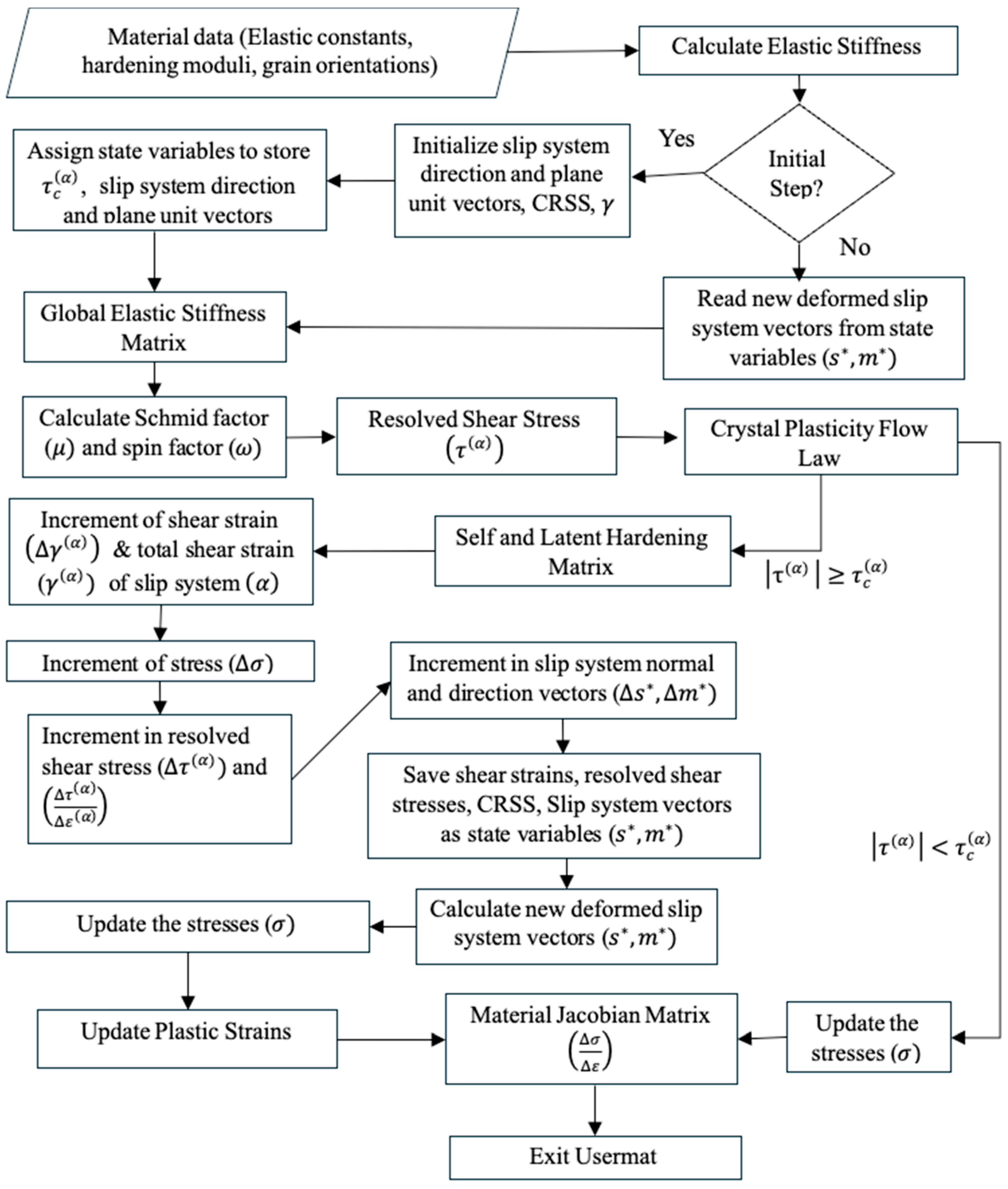

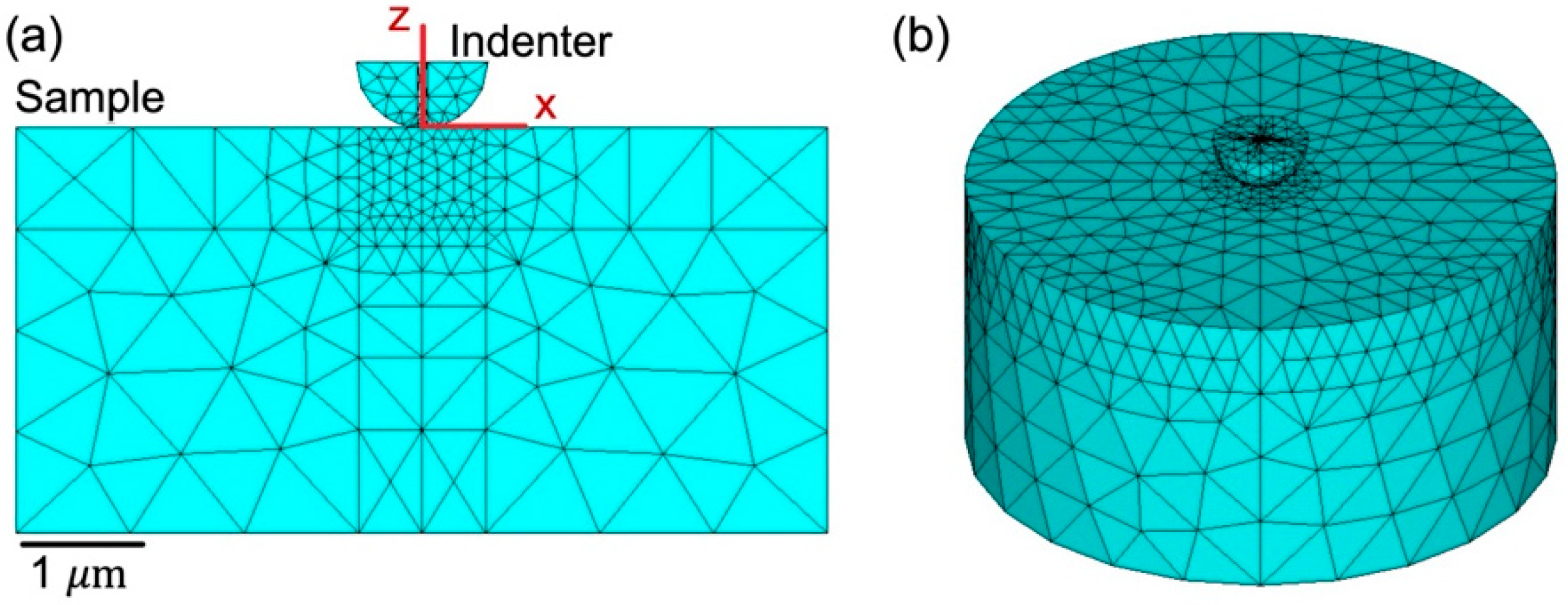

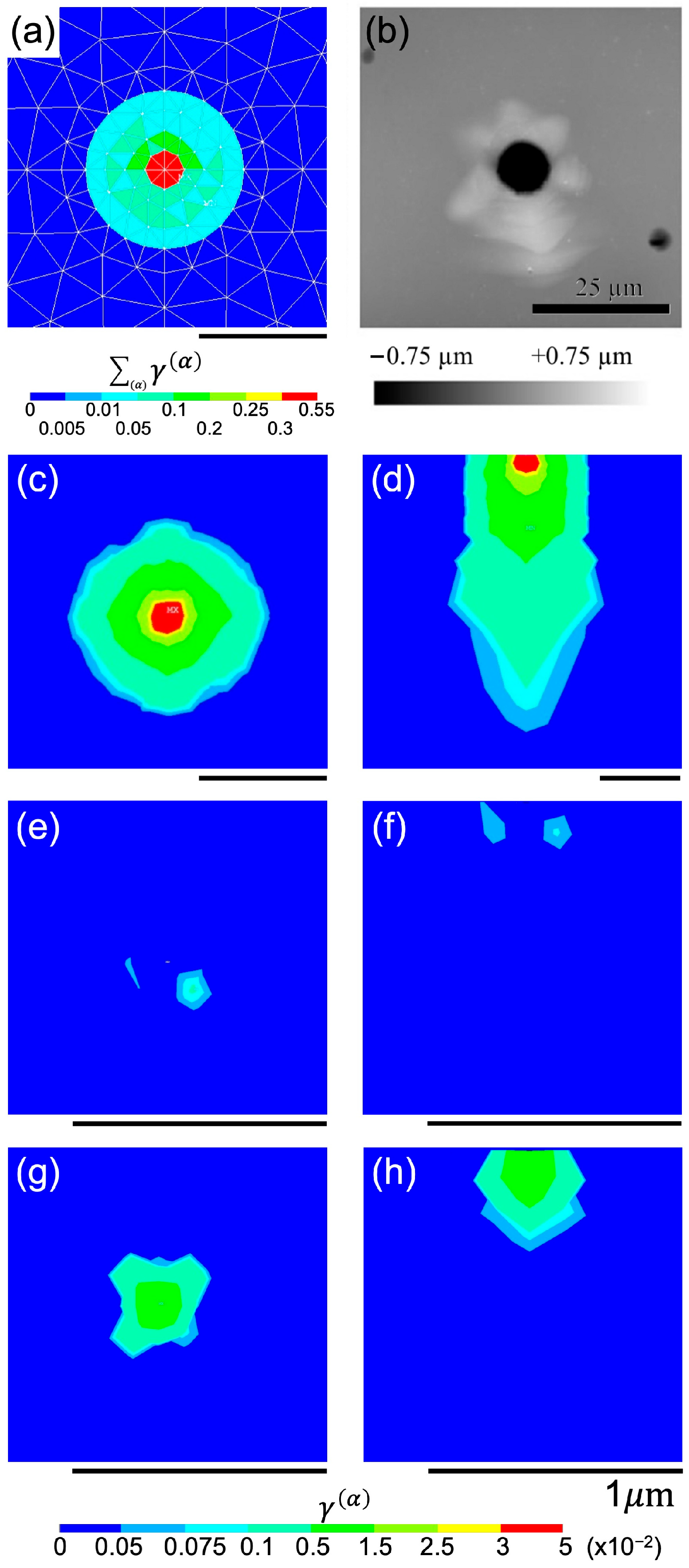
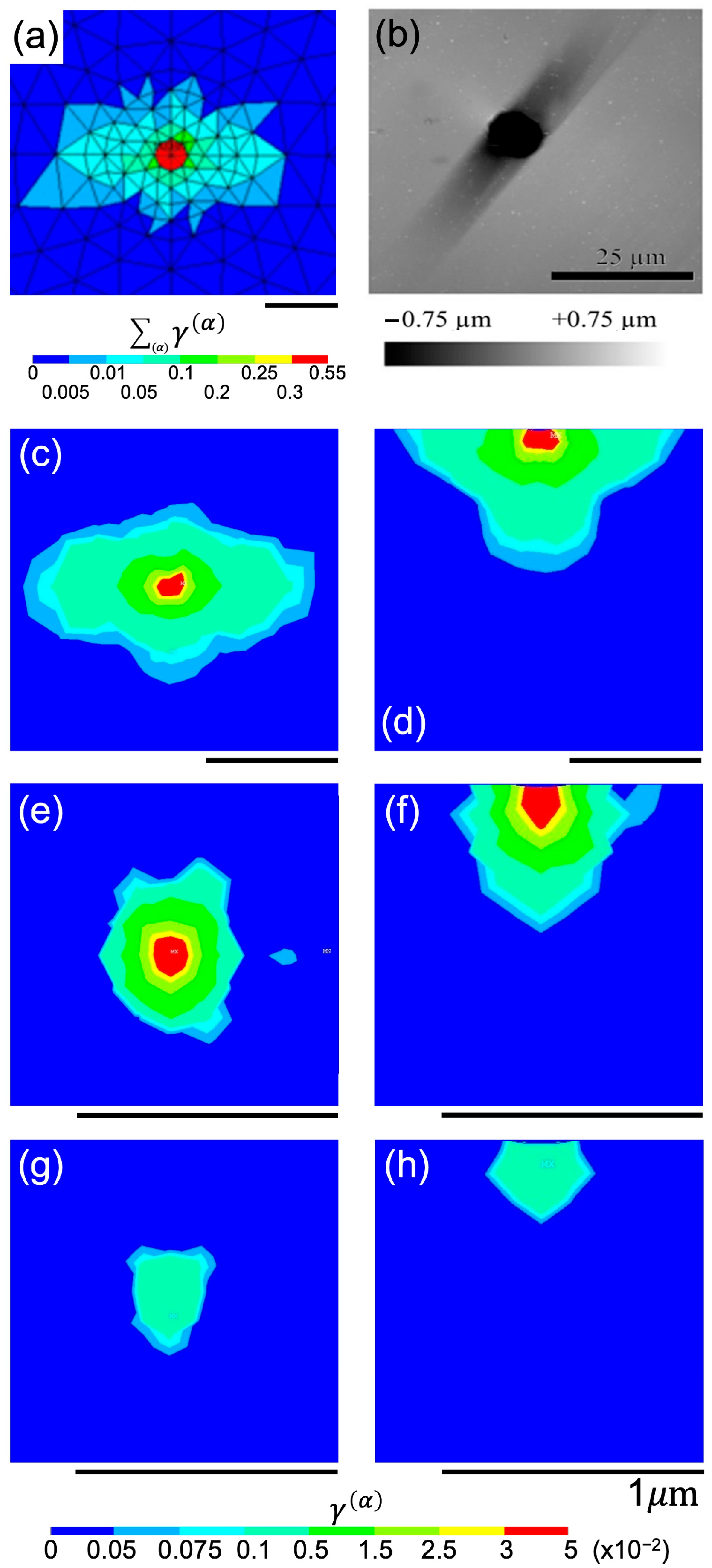
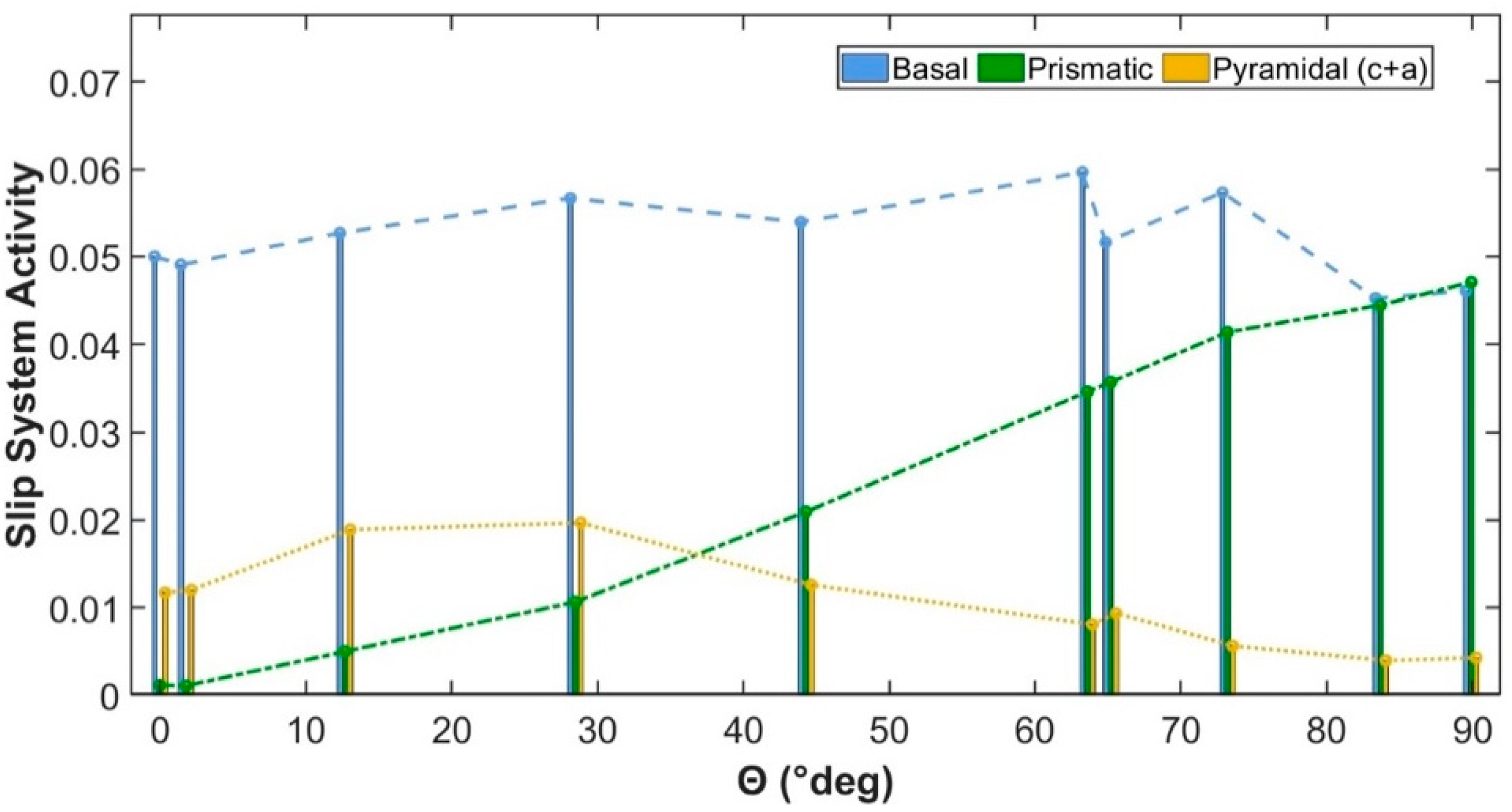
| Quantity | Basal (0001)<20> | Prismatic {010}<20> | Pyramidal <c + a> {112}<23> |
|---|---|---|---|
| (MPa) | 10 | 7500 | 7500 |
| (MPa) | - | 150 | 260 |
| (MPa) | 1.4 | 20 | 40 |
| Basal (0001)<20> | Prismatic {010}<20> | Pyramidal <c + a> {112}<23> | |
|---|---|---|---|
| Basal (0001)<20> | 1.0 | 1.0 | 1.0 |
| Prismatic {010}<20> | 0.5 | 0.5 | 0.5 |
| Pyramidal <c + a> {112}<23> | 1.0 | 1.0 | 0.2 |
Disclaimer/Publisher’s Note: The statements, opinions and data contained in all publications are solely those of the individual author(s) and contributor(s) and not of MDPI and/or the editor(s). MDPI and/or the editor(s) disclaim responsibility for any injury to people or property resulting from any ideas, methods, instructions or products referred to in the content. |
© 2025 by the authors. Licensee MDPI, Basel, Switzerland. This article is an open access article distributed under the terms and conditions of the Creative Commons Attribution (CC BY) license (https://creativecommons.org/licenses/by/4.0/).
Share and Cite
Khursheed, S.T.; Foumani, M.I.; Luo, Y.; Zhu, G.-z. Open-Access Crystal Plasticity Finite Element Implementation in ANSYS for Dislocation-Induced Nanoindentation in Magnesium. Inventions 2025, 10, 77. https://doi.org/10.3390/inventions10050077
Khursheed ST, Foumani MI, Luo Y, Zhu G-z. Open-Access Crystal Plasticity Finite Element Implementation in ANSYS for Dislocation-Induced Nanoindentation in Magnesium. Inventions. 2025; 10(5):77. https://doi.org/10.3390/inventions10050077
Chicago/Turabian StyleKhursheed, Syed Taha, Moein Imani Foumani, Yunhua Luo, and Guo-zhen Zhu. 2025. "Open-Access Crystal Plasticity Finite Element Implementation in ANSYS for Dislocation-Induced Nanoindentation in Magnesium" Inventions 10, no. 5: 77. https://doi.org/10.3390/inventions10050077
APA StyleKhursheed, S. T., Foumani, M. I., Luo, Y., & Zhu, G.-z. (2025). Open-Access Crystal Plasticity Finite Element Implementation in ANSYS for Dislocation-Induced Nanoindentation in Magnesium. Inventions, 10(5), 77. https://doi.org/10.3390/inventions10050077








